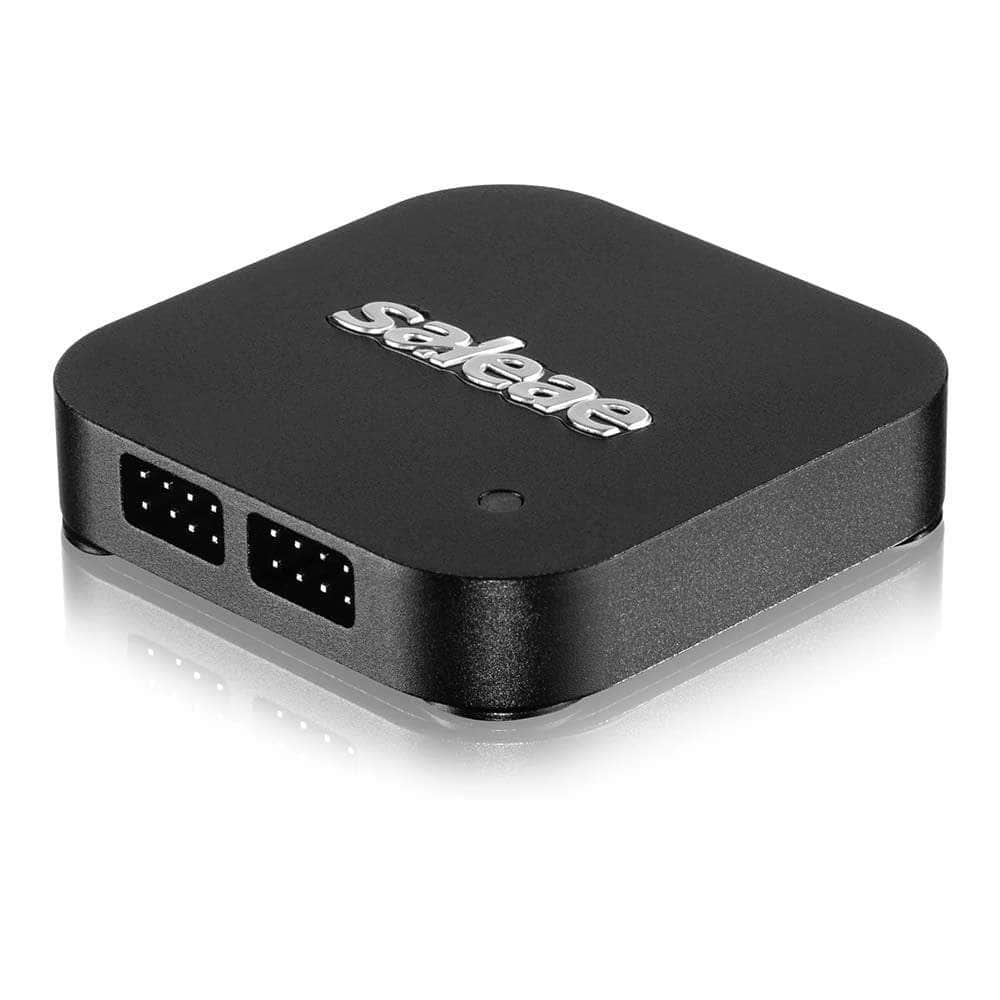
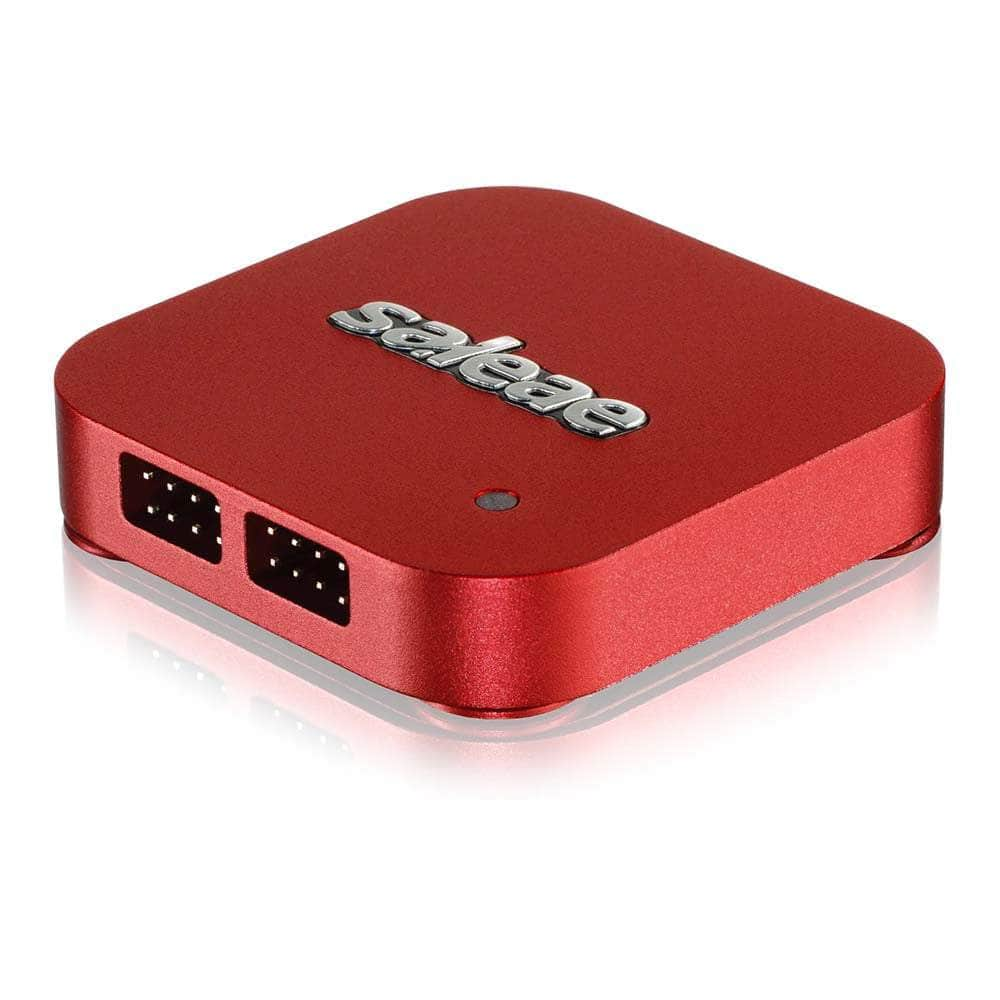
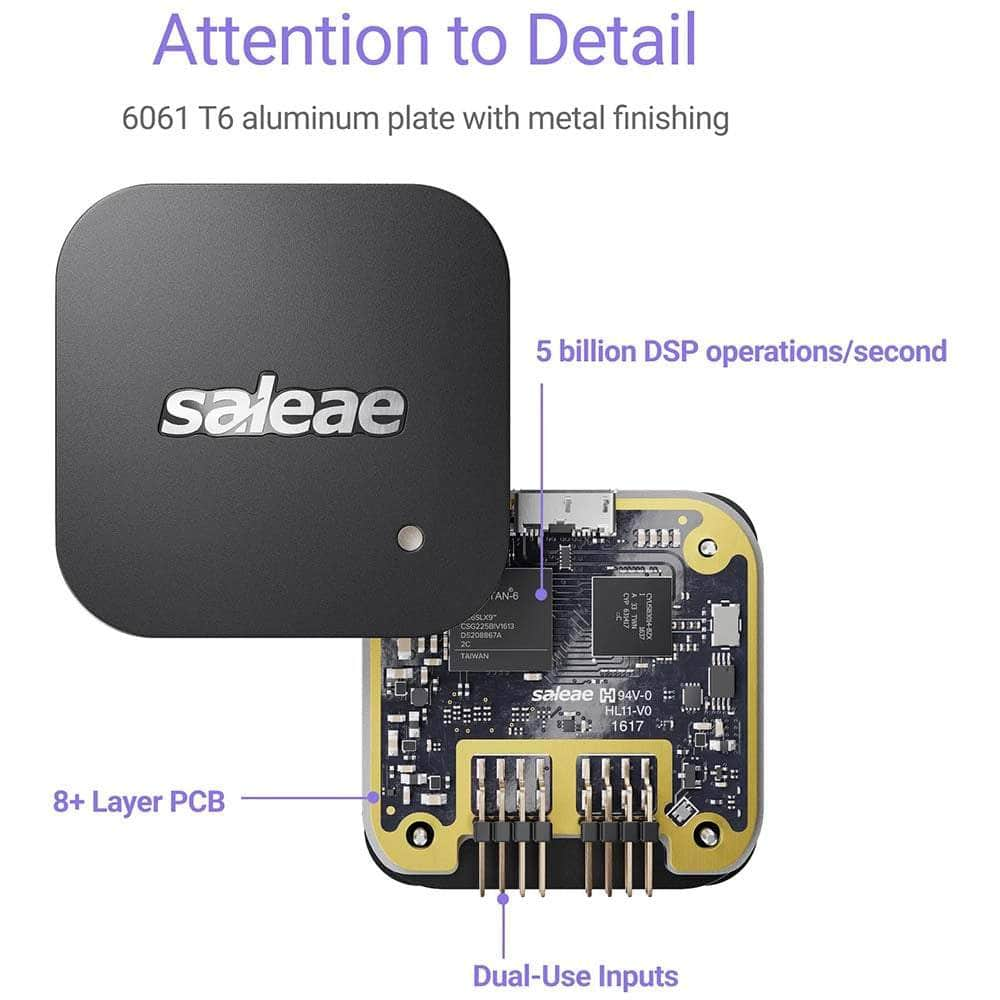
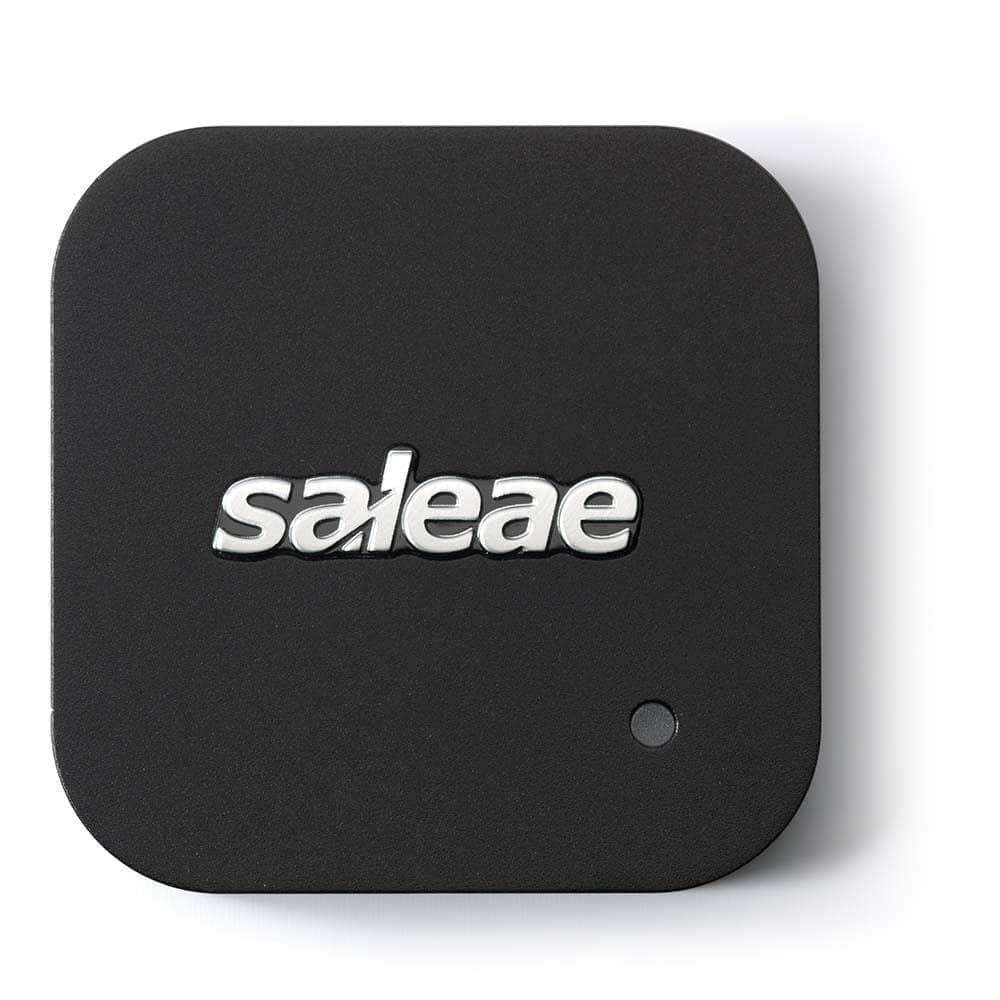
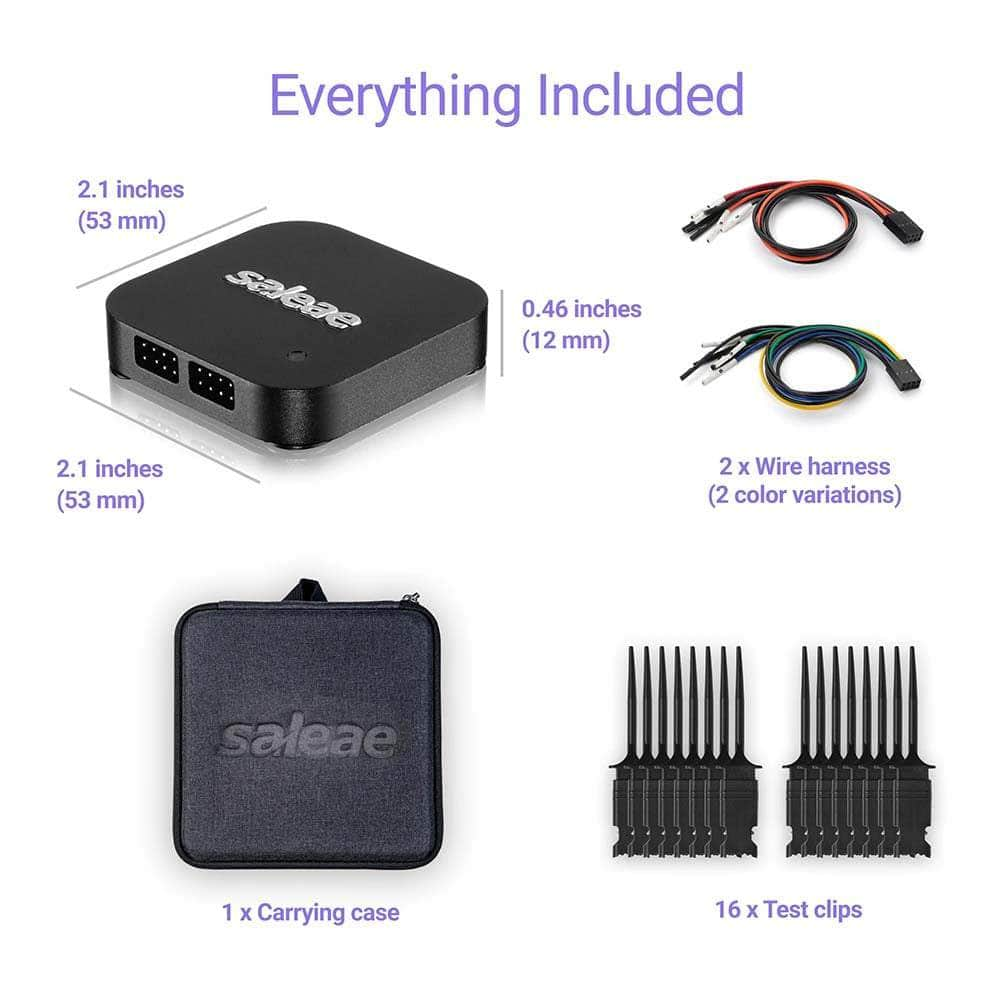
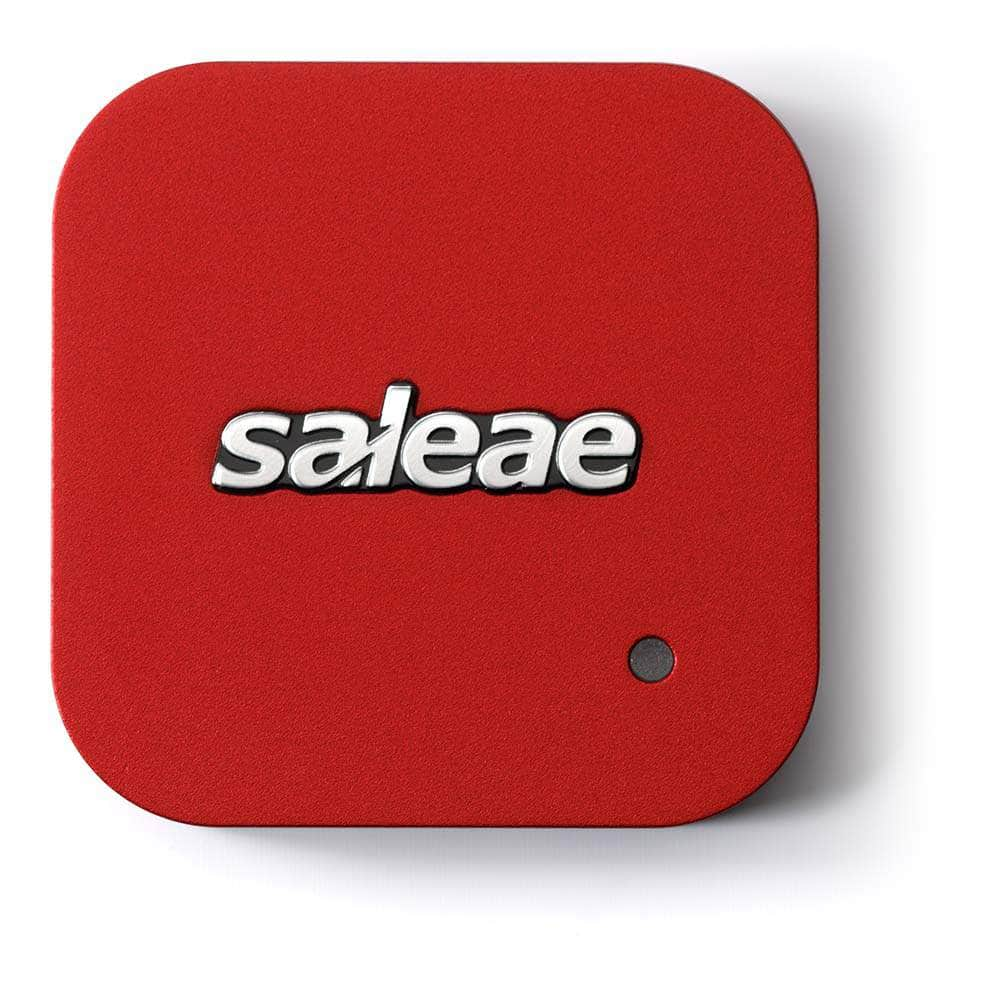
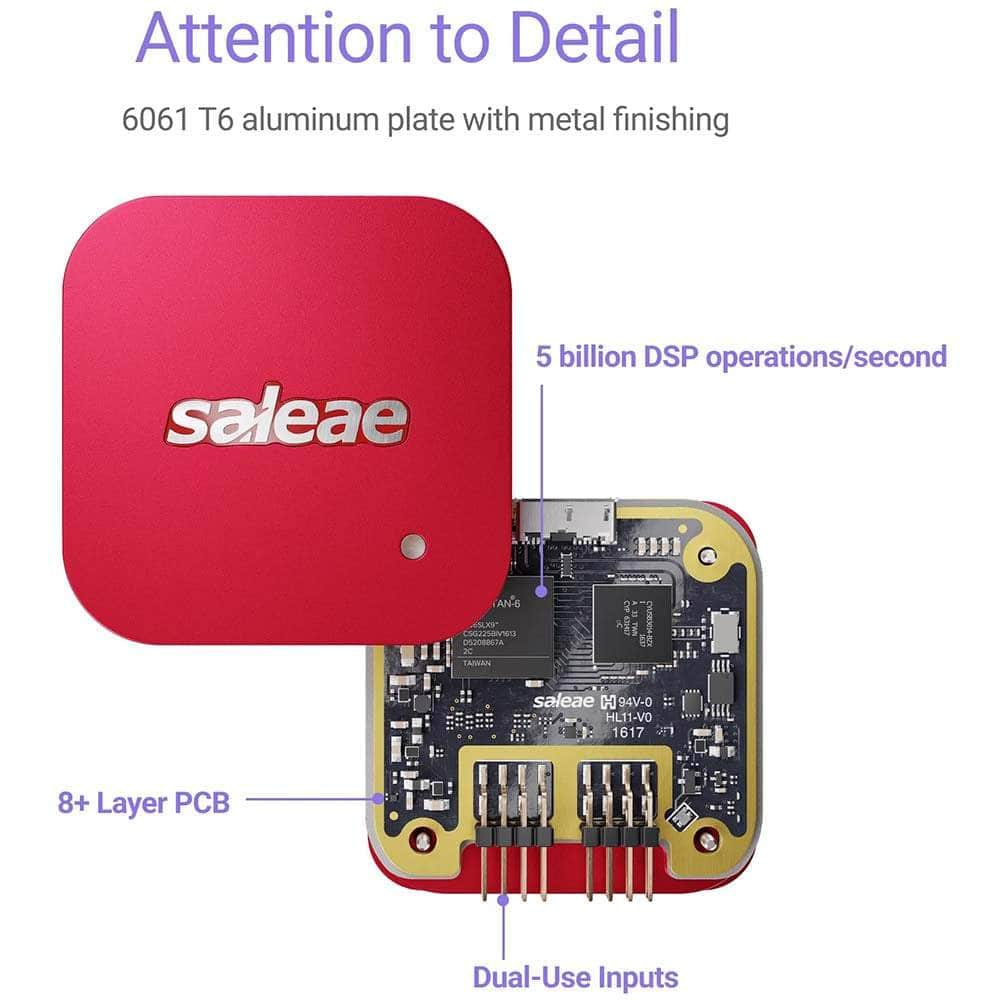
Key Features
Overview
The Saleae Logic Pro 8 is a compact, high-performance USB logic and analogue analyser designed for embedded systems engineers and hardware developers. It features 8 multi-use inputs, each capable of digital and analogue capture, delivering up to 500 MS/s digital sampling on four channels or 100 MS/s across all eight (USB 3.0 required), and analogue sampling up to 50 MS/s at 12-bit resolution
With a generous −10 V to +10 V analogue input range, 12-bit resolution (~4.88 mV per LSB), and robust bandwidth (100 MHz digital, 5 MHz analogue), it offers professional-grade signal integrity backed by dedicated ground wires, ±25 V over-voltage protection, 2 MΩ input resistance, and ~10 pF capacitance
Engineered for portability, it’s housed in a precision-machined aluminium enclosure (53 × 53 × 12 mm, ~60 g), and includes full accessories—test leads, clips, USB-Cable, carry case, and Getting Started guide—so you can deploy it immediately
Use it with the intuitive cross-platform Logic 2 software (Windows, macOS, Linux) to capture, visualise, analyse, and export data; ideal for debugging serial, SPI, I²C, CAN, JTAG and more
Downloads
Why Engineers Choose The Saleae Logic Pro 8 Logic/Analogue Analyser
Digital & analogue capture, same inputs
Up to 500 MS/s digital, 50 MS/s analogue
ightweight, sturdy, includes full kit
Full Description
The Saleae Logic Pro 8 by Saleae is a professional mixed-signal logic analyser designed for Electronic Design Engineers who need fast, reliable protocol decode and deep visibility into digital and analogue behaviour during debugging. With 8 dual-purpose inputs that each capture digital and analogue, digital sample rates up to 500 MS/s (on up to four channels) or 100 MS/s across all eight, and analogue sampling up to 50 MS/s at 12-bit resolution, Logic Pro 8 pairs lab-grade specifications with a compact 53 × 53 × 12 mm aluminium enclosure for bench or field work. USB 3.0 streaming enables long captures limited primarily by system RAM, while cross-platform Logic 2 software accelerates capture, measurement and decode on Windows, macOS and Linux. :contentReference[oaicite:0]{index=0}
Mixed-Signal Architecture: One Probe Per Signal, Digital and Analogue Together
Each of the eight inputs records both digital state and analogue voltage on the same pin, so you can correlate protocol activity with real-world signal integrity without changing setups. Engineers can, for example, decode I²C while simultaneously examining pull-up strength and rise times, or verify SPI timing while checking analogue overshoot on SCLK or MOSI. This reduces fixture changes, eliminates probe re-arrangement, and shortens time-to-insight—especially when intermittent edges, crosstalk or power-rail coupling are at play. The ability to pair clean digital decoding with a −10 V to +10 V analogue input range at 12-bit (4.88 mV/LSB) gives enough headroom to examine 5 V logic with analogue margins, op-amp outputs in sensor boards, or 12 V-level translated GPIO lines in the same capture. :contentReference[oaicite:1]{index=1}
High-Speed Sampling and Bandwidth for Modern Buses
Logic Pro 8 sustains 500 MS/s digital on up to four channels or 100 MS/s across all eight when connected via USB 3.0, providing timing visibility for 100 MHz digital bandwidth signals. Analogue capture runs to 50 MS/s with a 5 MHz (−3 dB) analogue bandwidth, ideal for viewing rise/fall behaviour, ringing and supply dips around switching events and moderate-frequency PWM. Practically, that means you can inspect a 50 MHz SPI clock’s duty cycle, verify UART sampling points well beyond 1 Mbaud, and confirm I²S/PCM frame timing while checking analogue rail droop during burst activity—all in a single session. USB 3.0 is required for maximum rates; the software adapts available sample-rate/channel combinations automatically to the host’s bandwidth. :contentReference[oaicite:2]{index=2}
Signal Integrity: Protection, Impedance and Grounding That Respect Your DUT
The input front end is engineered to be present but unobtrusive. Inputs present approximately 2 MΩ ∥ 10 pF, minimising loading on high-impedance nodes and preserving edge fidelity on typical MCU and FPGA pins. Continuous ±25 V over-voltage protection safeguards the instrument during bring-up and probing, while a user-selectable digital threshold supports common logic families—1.2 V, 1.8 V, 2.5 V, 3.3 V, 5 V as well as RS-232, RS-485/422 and +12 V TTL. Dedicated ground leads shipped with the harness help reduce loop area and noise pickup, which translates into repeatable captures and fewer “phantom glitches” when you’re chasing marginal timing. :contentReference[oaicite:3]{index=3}
Logic 2 Software: Fast Capture, Measurement and Protocol Decode
The cross-platform Logic 2 application turns raw samples into insight quickly. Built-in analysers decode a wide range of protocols—including SPI, I²C, UART/Serial, CAN, LIN, I²S/PCM, MDIO, JTAG and more—while measurement cursors, bookmarks and search/filter tools help pinpoint anomalies across long captures. Engineers can export data to CSV, VCD, binary or MATLAB for post-processing, automate repetitive tasks via the Automation API, or extend capability with custom protocol decoders. This combination of decode breadth and workflow tooling shortens root-cause analysis from hours to minutes on typical embedded bring-up and regression investigations. :contentReference[oaicite:4]{index=4}
Deep, Practical Recording: Long Runs without Losing Detail
Rather than a fixed internal memory, captures stream over USB to host RAM, making recording length primarily a function of installed memory and data activity. That means you can record for seconds, minutes or hours depending on bus idleness and selected rates—useful for chasing rare watchdog resets or sporadic bus contention. Example combinations from Saleae include 8-channel digital at 100 MS/s and 3-channel analogue at 50 MS/s, with the software presenting legal options based on channel selection and the host’s bandwidth. For teams tracking regressions over time, consistent capture presets ensure repeatable sampling across hosts. :contentReference[oaicite:5]{index=5}
Portable, Robust Hardware for Bench and Field
A 53 × 53 × 12 mm CNC-machined aluminium enclosure weighing about 60 g drops into a tool bag without fuss, yet sits firmly on the bench beside an oscilloscope or power analyser. The included kit—USB 3.0 cable, two 2×4 wire harnesses, sixteen micro-gripper hooks and a carry case—covers most probing situations immediately; additional harnesses and clip sets are available when you need to fan-out to headers and fine-pitch test points across larger assemblies. The compact footprint matters when you’re probing inside enclosures or crowded EVT rigs where clearance is tight and ground referencing is awkward. :contentReference[oaicite:6]{index=6}
Everyday Debugging Scenarios
SPI mode mismatch: Capture MOSI, MISO, SCLK and CS at 100 MS/s to confirm whether a peripheral expects CPOL/CPHA different from your firmware; verify with the analyser’s SPI decoder while the analogue trace confirms overshoot on SCLK isn’t double-clocking the part. I²C NACKs during bring-up: Use two digital channels for SDA/SCL and an analogue channel on the 3.3 V rail at 50 MS/s to spot a supply dip coincident with an address phase, leading you to add bulk capacitance or tune rise times. UART framing errors: Decode at 921,600 baud with timing markers to measure jitter; the analogue overlay highlights a marginal threshold on a long cable that you mitigate by increasing drive or adding a buffer. CAN bus intermittents: Trigger on error frames, then inspect analogue symmetry to uncover poor termination. Power sequencing on embedded SOMs: Allocate several channels to rails and enables; 12-bit analogue resolution helps you verify millisecond offsets and brings up PMIC dependencies cleanly. :contentReference[oaicite:7]{index=7}
Choosing the Right Model for Your Project
Logic Pro 8 is an excellent fit when you need 8 channels with high digital timing performance and useful analogue visibility on embedded designs, motor controllers, audio interfaces and instrumentation. If your system spans wider buses or concurrent interfaces—say, parallel RGB with auxiliary control, or multiple SPI and UART channels—consider moving up to the Saleae Logic Pro 16 mixed-signal logic analyser for 16 channels at the same per-channel performance. For teams that primarily need digital timing without analogue capture and want a smaller budgetary footprint, the Saleae Logic 8 logic analyser provides eight digital channels and integrates with the same Logic 2 workflow. :contentReference[oaicite:8]{index=8}
Related Products from The Debug Store
Extend your setup with proven, compatible options available in-store. When you need more channels for parallel buses or simultaneous interface captures, the Saleae Logic Pro 16 mixed-signal logic analyser is the natural upgrade. For higher fan-out or permanent fixtures, add spare harnesses such as the Saleae 2×4 test-clip wire harness to speed repeatable probing across boards. If you require deep memory and ultra-high timing on many channels for complex digital systems, explore advanced options like the Acute TravelLogic 34-channel logic analyser or ZeroPlus LAP-C Pro series logic analyser, which deliver expanded channel counts and very high sampling ceilings for specialised needs. :contentReference[oaicite:9]{index=9}
Specifications Summary and Software Compatibility
Channels: 8 digital/analogue shared. Digital rates: 500, 100, 50, 25, 12.5, 10, 6.25, 5, 4, 2.5, 2, 1 MS/s (500 MS/s on up to four channels via USB 3.0). Digital bandwidth: 100 MHz. Analogue rates: up to 50 MS/s with 5 MHz bandwidth. ADC: 12-bit, 4.88 mV/LSB. Analogue input range: −10 V to +10 V. Protection: continuous −25 V to +25 V. Input impedance: ~2 MΩ ∥ 10 pF. PC connection: USB 3.0 SuperSpeed (USB 2.0 supported with reduced performance). OS support: Windows, macOS and Linux with the Logic 2 software. These specifications come directly from the Saleae datasheet and support materials to ensure accurate selection and comparison for your next project. :contentReference[oaicite:10]{index=10}
| General Information | |
|---|---|
Part Number (SKU) |
SAL-00113
|
Model |
|
Colour |
|
Manufacturer |
|
| Oscilloscope | |
Number of Channels |
|
Bandwidth |
|
Sample Rate |
|
Screen Size |
|
Touchscreen |
|
| Logic Analyser | |
Number of Logic Channels |
|
Max Sample Rate |
|
| Physical and Mechanical | |
Dimensions |
|
Weight |
0.5 kg
|
Operating Temperature |
|
Storage Temperature |
|
| Other | |
Certifications |
|
Warranty |
|
Country of Origin |
|
HS Code Customs Tariff code
|
|
EAN |
5055383602445
|
Frequently Asked Questions
Have a Question?
-
What are the key differences between the Logic 8 and Logic Pro 8?
The Logic Pro 8 represents a significant upgrade over the Logic 8, designed specifically for professional engineers and high-performance applications. The most fundamental difference is the USB connectivity: the Logic Pro 8 features USB 3.0 Super Speed compared to the Logic 8's USB 2.0, enabling dramatically higher data throughput capabilities.Performance SpecificationsDigital Sampling: Logic Pro 8 achieves up to 500 MS/s on 4 channels or 100 MS/s on all 8 channels, whilst Logic 8 is limited to 100 MS/s maximum (25 MS/s on all 8 channels)Maximum Bandwidth: Logic Pro 8 supports 100 MHz digital bandwidth compared to Logic 8's 25 MHz limitAnalogue Performance: Logic Pro 8 delivers 50 MS/s at 12-bit resolution (5 MHz bandwidth), significantly outperforming Logic 8's 10 MS/s at 10-bit resolution (1 MHz bandwidth)Professional FeaturesThe Logic Pro 8 includes several professional-grade capabilities absent in the Logic 8: selectable logic threshold support down to 1.2V (versus 1.8V minimum on Logic 8), bipolar analogue inputs supporting ±10V range, and 2 MΩ input resistance compared to Logic 8's 1 MΩ. The Logic Pro 8 also features superior signal integrity with its more advanced PCB design, using more layers than Logic 8's 8-layer construction.Application SuitabilityWhilst the Logic 8 excels at general-purpose debugging and moderate-speed protocols, the Logic Pro 8 is specifically engineered for medium-speed FPGA applications, low-voltage designs, high-precision measurements, and high-speed protocol decoding. The USB 3.0 interface enables real-time streaming of higher bandwidth data, making it ideal for data-intensive applications such as 8-channel I2S audio analysis or high-speed SPI debugging.Both devices share the same 8 dual-purpose channels, unlimited sample depth, ±25V protection, and comprehensive protocol decoding capabilities. However, the Logic Pro 8's superior performance specifications and professional features make it the preferred choice for demanding embedded systems development where signal integrity and measurement precision are critical.
-
What accessories and connectivity options are included with the Logic Pro 8?
The Logic Pro 8 comes complete with professional-grade accessories including two sets of 4-channel wire harnesses, 16 micro-gripper hooks, a premium carrying case, and a USB 3.0 cable. The colour-coded, numbered test leads feature ultra-flexible construction and dedicated ground wires for optimal signal integrity. Each channel includes removable test clips for connecting to pins, headers, and wires. The device also features a customisable RGB LED for status indication and operates entirely from USB bus power, requiring no external power supply. This comprehensive accessory package enables immediate deployment in professional environments.
-
How do Logic Pro 8's triggering and measurement capabilities enhance debugging workflows?
The Logic Pro 8 features advanced triggering capabilities including edge detection, pulse width triggering, and sophisticated protocol-based triggering that can capture specific communication events. The measurement system provides real-time timing analysis, voltage measurements, and statistical analysis through both built-in and community-developed measurement extensions. Unlike oscilloscopes that only show data in real-time, the Logic Pro 8 records all activity for post-capture analysis, enabling engineers to examine complex timing relationships and intermittent issues that might be missed with traditional instruments.
-
What applications and industries benefit most from Logic Pro 8?
The Logic Pro 8 excels in firmware debugging, FPGA development, functional verification, and reverse engineering applications. It's particularly valuable for embedded systems developers working with microcontrollers, IoT devices, and communication protocols. Industries including automotive, aerospace, telecommunications, and industrial automation rely on the Logic Pro 8 for protocol debugging and signal integrity analysis. The device's ability to capture both analogue and digital signals makes it essential for mixed-signal debugging scenarios where power supply issues interact with digital communications.
-
How does the Logic Pro 8's software compare to alternatives in terms of usability and features?
The Logic 2 software represents the gold standard for logic analyser interfaces, consistently praised for its intuitive design and powerful features. Unlike competing products that often suffer from buggy, crash-prone software, the Saleae platform provides rock-solid stability across Windows, macOS, and Linux platforms. Key software advantages include fluid mouse-driven navigation, real-time protocol triggering and searching, advanced measurement tools with community extensions, and comprehensive export options (CSV, Binary, VCD, MATLAB). The software also features a fully-functional demo mode, allowing engineers to evaluate capabilities before purchase.
-
What are the key specifications and technical capabilities of the Logic Pro 8?
The Logic Pro 8 offers professional-grade specifications including 500 MS/s maximum digital sampling rate (100 MS/s when using all 8 channels), 50 MS/s analogue sampling with 12-bit resolution, and 5 MHz analogue bandwidth. The device supports logic levels from 1.2V to 5.5V with selectable threshold voltages of 0.6V, 0.9V, or 1.65V. Input protection extends to ±25V, and each channel features 2 MΩ input resistance and 10 pF capacitance for minimal circuit loading. The compact aluminium enclosure measures just 53×53×12mm and weighs only 60g, making it highly portable whilst maintaining professional build quality.
-
Which communication protocols can the Logic Pro 8 decode automatically?
The Logic Pro 8 supports comprehensive protocol decoding for all major embedded communication standards including SPI, I²C, UART/Serial, CAN bus, I2S/PCM, 1-Wire, and RS-232/422/485 communications. The device includes 24+ built-in protocol analysers with the ability to add community-developed decoders through the extension system. Advanced features include protocol filtering, search capabilities, and the ability to create custom high-level and low-level protocol analysers using the SDK. This extensive protocol support makes it ideal for debugging microcontroller communications, FPGA interfaces, and complex embedded systems.
-
What unique competitive advantages does the Saleae Logic Pro 8 offer for embedded systems development?
The Logic Pro 8's most significant competitive advantage is its dual-purpose channel architecture - each input can simultaneously record digital and analogue signals, enabling comprehensive mixed-signal analysis that would typically require separate instruments. The device features an advanced automation API for automated testing environments, something rarely found in competing products. Additionally, the Logic Pro 8 supports real-time USB 3.0 data streaming with automatic FPGA-based filtering and decimation to prevent aliasing, ensuring data integrity even during high-bandwidth captures. The included Saleae software provides unparalleled protocol decoding capabilities with community-developed extensions, offering far more flexibility than proprietary solutions.
-
How does the Logic Pro 8's performance compare to more expensive competitor solutions?
The Logic Pro 8 significantly outperforms more expensive alternatives in several key areas. Whilst premium oscilloscopes from Keysight can cost thousands of pounds just for basic protocol decoding software updates, the Logic Pro 8 includes 24+ built-in protocol analysers as standard. Unlike traditional high-end test equipment that may only offer 2-4 channels, the Logic Pro 8 provides 8 dual-purpose channels capable of 500 MS/s digital sampling and 50 MS/s analogue sampling with 12-bit resolution. The device also features superior signal integrity with dedicated ground wires for each channel and ±25V overvoltage protection, matching specifications found in instruments costing several times more.
-
What is the Saleae Logic Pro 8, and how does it differ from traditional logic analysers?
The Saleae Logic Pro 8 is a professional-grade USB-powered mixed-signal logic analyser that combines both digital and analogue signal capture capabilities in a compact, portable design. Unlike traditional bench-top logic analysers, the Logic Pro 8 connects directly to your computer via USB 3.0 and uses your PC's RAM as the sample buffer, enabling virtually unlimited capture length limited only by available system memory. Each of the 8 channels can simultaneously capture both digital and analogue signals, providing unprecedented flexibility for embedded systems debugging.







